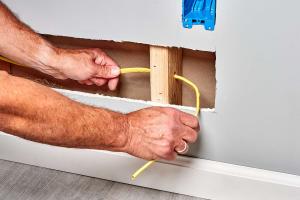Mastering Electrical Wiring: A Comprehensive Guide to Running Wires through Finished Walls

-
Quick Links:
- Introduction
- Understanding Electrical Wiring
- Safety First
- Tools and Materials Needed
- Planning the Project
- Step-by-Step Guide
- Common Issues and How to Solve Them
- Expert Insights
- Case Studies
- FAQs
Introduction
Running electrical wires through finished walls can seem daunting, especially for DIY enthusiasts. However, with the right knowledge and tools, you can complete this task safely and efficiently. This guide provides a detailed overview of everything you need to know, from planning your project to executing it flawlessly.
Understanding Electrical Wiring
Electrical wiring is the system of conductors and cables that carry electricity throughout your home. Understanding the basics of electrical wiring is crucial before you start running wires through finished walls. This section will cover:
- The components of electrical wiring: wires, outlets, switches, and circuits.
- Types of wiring: NM (non-metallic) cable, conduit, and more.
- Basic electrical principles: voltage, current, and resistance.
Safety First
Before you begin any electrical project, safety must be your top priority. Here are important safety tips:
- Always turn off the power at the circuit breaker before starting work.
- Use insulated tools to prevent electric shock.
- Wear safety glasses and gloves to protect yourself from debris.
- Check local electrical codes and obtain necessary permits.
Tools and Materials Needed
Having the right tools and materials is essential for a successful wiring project. Here’s a comprehensive list:
- Fish tape
- Drill and drill bits
- Wire cutters and strippers
- Voltage tester
- Electrical tape
- NM cable or conduit
- Outlet and switch boxes
Planning the Project
Effective planning can save you time and effort. Consider the following:
- Determine the layout of your wiring: where outlets and switches will be located.
- Calculate the total length of wire needed.
- Map out the path of the wires through the walls.
Step-by-Step Guide
Now that you have everything in place, let's dive into the step-by-step process for running electrical wires through finished walls:
1. Turn Off Power
Before starting, ensure the power is turned off at the breaker box. Use a voltage tester to confirm.
2. Plan Access Points
Identify where you will need to access the wall for wiring. This may include cutting holes for electrical boxes.
3. Use Fish Tape
Insert fish tape into one end of the wall cavity to guide the wire through. Pull it through the access point.
4. Secure the Wiring
Once the wire is pulled through, secure it properly using staples or clips.
5. Install Electrical Boxes
Install the outlet or switch boxes according to your plan. Ensure they are flush with the wall surface.
6. Connect Wires
Strip the ends of the wires and connect them to the respective terminals on the outlet or switch.
7. Test Your Work
Once everything is connected, turn the power back on and test the outlets and switches with a voltage tester.
Common Issues and How to Solve Them
Even experienced electricians encounter issues while running wires. Here are some common problems and solutions:
- Wire Getting Stuck: Use lubricant or adjust your angle of approach.
- Incorrect Wire Length: Always measure twice before cutting.
- Loose Connections: Ensure wires are securely fastened to terminals.
Expert Insights
We consulted with several electricians to provide expert tips for running electrical wires through finished walls:
- Always double-check local building codes before starting.
- Consider hiring a professional for complex wiring tasks.
- Keep your workspace organized to avoid accidents.
Case Studies
Here are two case studies showcasing successful projects:
Case Study 1: Home Renovation
A homeowner in Denver renovated their basement, running new electrical wiring for additional outlets. By following a structured plan and consulting an electrician, they completed the project without issues.
Case Study 2: DIY Project Gone Wrong
A DIY enthusiast in Seattle attempted to run wires without planning and ended up with multiple issues. After consulting a professional electrician, they learned the importance of proper planning and safety measures.
FAQs
1. Can I run electrical wires through finished walls myself?
Yes, if you have the right tools, knowledge, and adhere to safety protocols.
2. What type of wire should I use?
NM cable is commonly used for residential wiring, but consult local codes for specifics.
3. Do I need a permit for running wires?
Yes, most local building codes require permits for electrical work.
4. How do I find existing wiring in walls?
Use a stud finder that detects electrical wires or consult a professional.
5. What safety gear should I wear?
Wear safety glasses, gloves, and insulated tools.
6. Can I run electrical wires horizontally in walls?
Yes, but ensure you adhere to local codes and avoid drilling through other wiring.
7. How do I secure the wiring in the wall?
Use staples or cable clips to secure wiring along studs.
8. What should I do if I encounter a problem?
Assess the issue carefully, and if unsure, consult a licensed electrician.
9. How do I test if the wiring is working?
Use a voltage tester to check for power at outlets and switches.
10. What are the common mistakes to avoid?
Avoid cutting wires too short, neglecting safety protocols, and failing to follow local regulations.
Random Reads
- How to see iphone call history
- How to see python version
- Ultimate guide backup play wii games usb
- Quickly change color background photoshop
- Real vs counterfeit yu gi oh cards
- How to import emails to gmail
- How to import excel into access
- How to unlock an oven
- How to unlock bosch oven
- Mastering dll file editing visual studio